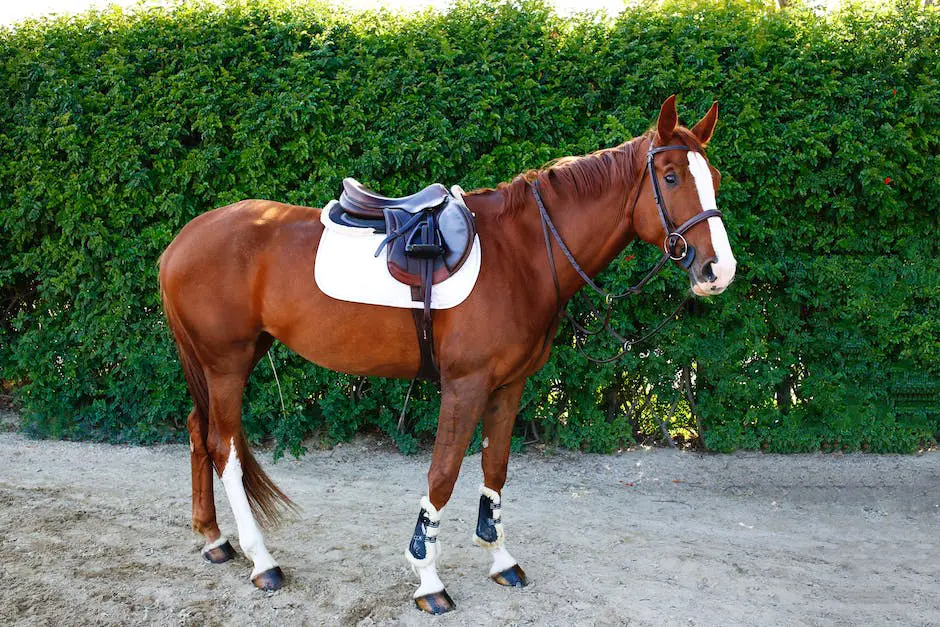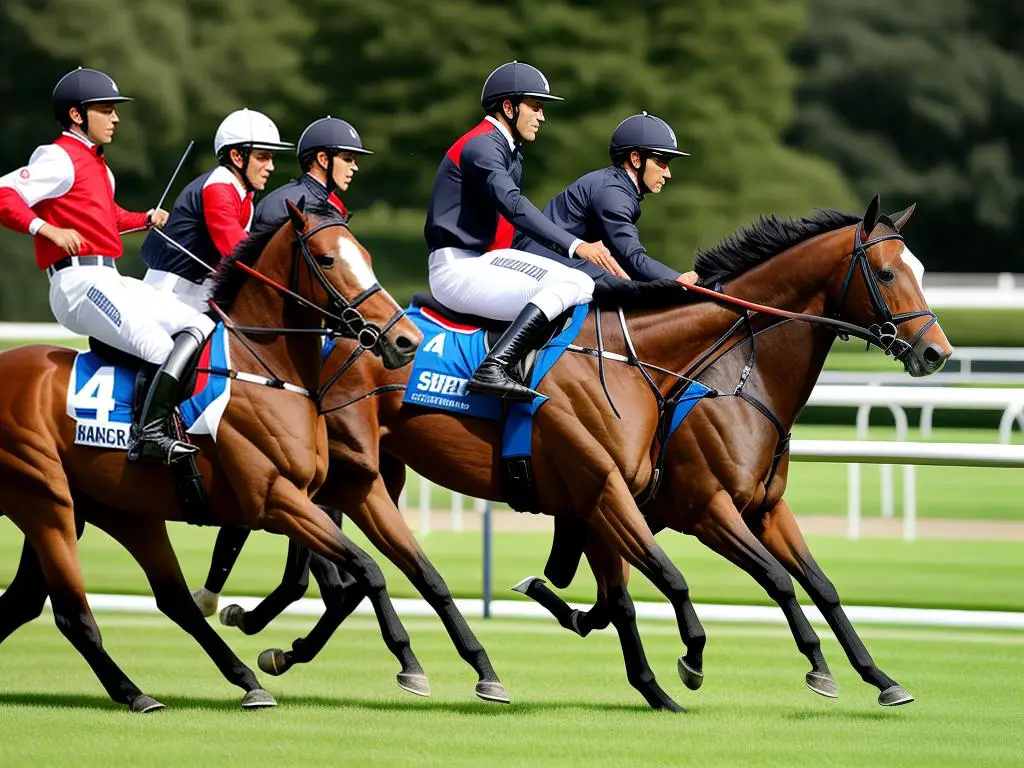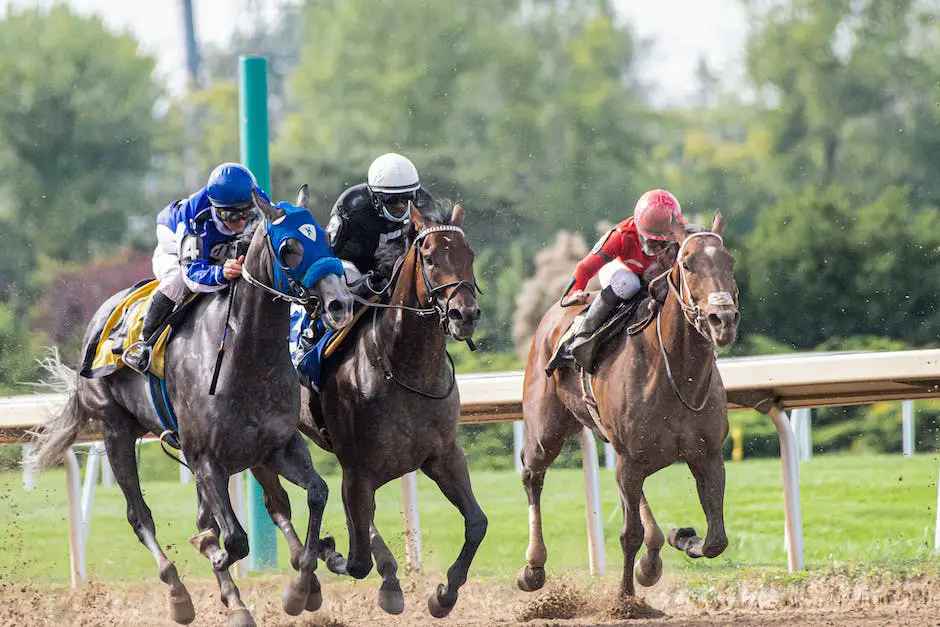Rich in tradition, shaped by history and brimming with equestrian excellence, the French horse racing industry intrigues a global audience with its charm and allure. Skipping across centuries, this narrative adopts a birds-eye-view of the origins and evolution of French horse racing, tracking its journey to becoming an integral part of modern French culture. Beyond merely a sport, horse racing in France is a spectacle that takes center stage in prestigious events, with each racecourse telling its own unique story. Add a sprinkling of world-renowned horse breeds and the dynamism of racehorse breeding, and the tapestry of the French racing industry becomes even more vibrant. From the elegance of the flat racing events to the thrill of jump racing, the spectacle of horse racing still pulsates through the veins of France, making it an irresistible destination for horse racing enthusiasts around the world.
Table of Contents (Horspedia)
History of French Horse Racing
Origins of French Horse Racing
French horse racing’s history dates back to the Roman Era, when chariot racing was an integral part of religious ceremonies and military parades. After the fall of the Roman Empire, horse racing evolved into a sport of knights and nobility during the Medieval period.
Impact of Social, Political, and Cultural Changes
The French Revolution brought about significant changes to French society, including the horse racing industry. Before the revolution, horse racing was primarily the sport of the nobility.
However, post the French Revolution, the sport was democratized, allowing the general public to participate and observe races. Over the years, French horse racing has become a popular recreational activity for both the locals and tourists.
The two World Wars significantly disrupted the French horse racing industry as the racecourses were either suspended or closed due to the war effort. After the wars, the French government took a keen interest in rebuilding the horse racing industry. They established PMU (Pari Mutuel Urbain), which revolutionized betting in horse racing, and by the 1960s, French horse racing had regained its pre-war popularity and status.
Modern French Horse Racing Industry
The French horse racing industry has evolved over the years to become one of the most significant in the world. France Galop, the governing body, oversees about 5,800 flat, jump, and trotting races each year, cementing this sport’s importance in French society and culture.
Some of the world’s most prestigious horse racing events, such as the Prix de l’Arc de Triomphe and the French Derby, take place in France and attract an international audience. France’s reputation as a breeding ground for some of the most superior racehorses also validates the high standing of French horse racing on a global stage.
Stricter rules on medication usage in French horse racing have drawn criticism yet have also set new standards for the sport to ensure equal opportunity and protect the welfare of the horses.
Increased media coverage of high-profile races, technological advances boosting betting efficiency, and the strong patronage from the State and the public have ensured the sustenance and growth of the French horse racing industry into the 21st century.
The French horse racing industry boasts a rich history and continued evolution, marking its resilience and enduring fascination. The intricate interplay of social, political, and cultural changes within the sphere of French horse racing is undeniable, and it continues to be a notable part of French society today.

Major Horse Races in France
Highlighting the Creme de la Creme of French Horse Races
Exploring the realm of French horse racing presents a panorama filled with luxury, nail-biting races, and intense drama. The crowning jewels of French equestrian sports are undoubtedly the Prix de l’Arc de Triomphe and the Grand Steeple-Chase de Paris. These esteemed events project an unmatched magnificence, encapsulating the rich heritage of French horse racing.
Prix de l’Arc de Triomphe: The Opulence of French Flat Racing
The Prix de l’Arc de Triomphe is indeed the pinnacle of French horse racing. Conceived in 1920, its name was in honor of French soldiers who fought in WWI. This annual Group 1 flat horse race unfolds at the Longchamp Racecourse located in the heart of Paris, near the banks of the Seine and is generally held on the first Sunday of October. Known colloquially as ‘The Arc,’ it is open to thoroughbreds aged three years or older and boasts the second largest purse in the world, only behind the Pegasus World Cup.
The Arc’s 2,400 meters of turf track introduces a balanced challenge between both stamina and speed. The racecourse itself stands proud, a state-of-the-art facility equipped with aesthetic and functional elegance. The pivotal moment is when the horses turn into the home straight and viewers worldwide hold their breath in anticipation of who will be crowned the champion.
Grand Steeple-Chase de Paris: Leap of Glory
Another gem in the crown of French horse racing is the Grand Steeple-Chase de Paris, the embodiment of the thrill and majesty of French jump racing. The race is held annually at Auteuil Racecourse, Paris, typically in May. This race is deemed as the most distinguished event of its type in France, as it invites top-tier jump horses to compete.
The challenging 6,000 meter-long course with its 23 jumps, including the infamous Riviere des Tribunes, requires horses to possess exceptional jumping skills and extraordinary stamina. The prestigious event, much like ‘The Arc,’ draws a global audience, casting a spell of untamed excitement and suspense.
The Global Significance of French Horse Racing Industry
French horse racing’s star events have consistently established their significance in the international racing scene. The Prix de l’Arc de Triomphe and the Grand Steeple-Chase de Paris have become definitive meetings for international bettors, enthusiasts, and professionals alike. In particular, the Prix de l’Arc de Triomphe has produced many champions who have gone on to earn international acclaim, making it a magnet for the world’s top equine talents.
In a broader sense, these events emphasize French horse racing’s pioneering role in establishing stringent regulations to maintain integrity, ensuring high specifications for horse welfare, and aiding the development of the equestrian sport worldwide. From the distinctive Trakehner jump in the Grand Steeple-Chase de Paris to the undeniable allure of the Prix de l’Arc de Triomphe, the French horse racing industry has truly amplified the thrill of competitive horse racing, making it a worldwide phenomenon.
French horse racing encapsulates the essence of the country’s rich culture, sport, and exciting entertainment. From breathtaking cityscape races in Paris to rustic provincial racecourses, the French equine industry promises an unforgettable experience for its spectators.

French Racing Horses and Breeds
Exploring the Breeds of the French Racing Industry
French racing doesn’t just offer sensational backdrops, but also introduces a plethora of indigenous horse breeds, each recognized for their unique attributes and prowess. Notable strains that dominate France’s racing landscape comprise the robust French Trotter, the versatile Selle Français, the agile Camargue, and the strong Percheron.
French Trotter: The Pinnacle of Harness Racing
The French Trotter, a breed specifically developed for harness racing, is a prominent figure in the French racing industry. This breed is known for its speed and endurance. Most notably, French Trotters often participate in international competitions, showcasing their racing prowess.
Selle Français: The Jump Racing Expert
The Selle Français breed, on the other hand, excels in jump racing. Known for their athleticism and agility, these horses have a reputation for heart-stopping performances at events such as the Prix de l’Arc de Triomphe and the Cheltenham Festival.
Camargue: The Symbol of the Wild French Coast
The Camargue is another notable breed, although not primarily known for its racing capabilities. Residing in the wetlands of southern France, the breed’s hardiness and sure-footedness are valuable traits. These horses have a unique appearance with their white coats, exuding a certain rustic charm that is reflective of their natural habitat.
Percheron: The Strength and Dignity of French Breeds
Although Percherons are not typically racing horses, it’s worth mentioning this heavyweight breed. Renowned for their power and gentle nature, Percherons contribute to the diversity and richness of the French equine population.
Breeding and Preservation Efforts in France
France’s horse racing industry is not solely about competition. Efforts to preserve and improve these horse breeds are a significant part of the industry, with several French stud farms dedicated to ensuring the longevity and quality of these breeds.
The National Stud, established in the late 19th century, is one such notable institution. Experts at the stud carefully maintain records of each horse born in France, overseeing breeding programs to improve traits and preserve the integrity of the different horse breeds.
International Triumphs of French Thoroughbreds
The excellence of French horse breeds is not limited to their local boundaries, but rather their triumphs extend to prestigious global competitions. The illustrious victories of French horses in major competitions such as the Prix de l’Arc de Triomphe and the English Grand National have displayed their outstanding capabilities. This success is attributed to a blend of careful selective breeding, intensive training regimes, top-notch veterinary care, and a unique, systematic approach to race preparation that is quintessentially French.
With the French racing industry’s commitment to exemplary quality and relentless enhancement, French horse breeds maintain their position as some of the finest globally. They effortlessly impress in international competitions, making them a force to be reckoned with.

Regulation and Economy of French Horse Racing Industry
The workings of the French horse racing industry are under the affluence of two key regulatory bodies: France Galop and Le Trot (formerly known as the Societe d’Encouragement du Cheval Francais). France Galop specializes in three distinct types of horse races, namely flat racing, steeplechasing, and hurdling, while Le Trot is the custodian of trotting races, further bifurcated into mounted and harness races.
Both France Galop and Le Trot operate under the broader regulatory umbrella of the French Ministry of Agriculture, and they are tasked with setting the rules, regulations, and racing calendar for the industry. Their critical responsibility is the seamless organization and overall supervision of the horse racing sector. These regulators’ primary aim is to ensure fair play and integrity in horse racing, all while prioritizing the welfare and safety of the animals.
In addition to this, Pari Mutuel Urbain (PMU) holds the monopoly on the organization of pari-mutuel betting in France. PMU not only regulates betting on horse races but also finances the industry since a significant portion of its turnover is redistributed within the sector.
The French horse racing industry plays a significant role in the French economy. With over 230 horse racing courses across the country, France has more racecourses than any other European country. In 2018, betting on French horse racing generated approximately €9.3 billion in stakes. Equine activities contribute to the employment of around 180,000 persons directly or indirectly, making the industry a significant job creator in rural areas.
Besides generating revenue through betting, the horse racing industry supports other businesses, including equine care, fodder production, tourism, media, and betting services. This broad purview reveals the industry’s substantial impact on the economy, beyond ticket sales and wagering.
In addition, the racing sector contributes notably to the country’s tourism industry. Prestigious racing events such as the “Prix de l’Arc de Triomphe” and “Prix du Jockey Club” attract thousands of local and international tourists each year.
Despite its significant contributions to the French economy, the horse racing industry faces numerous challenges. Chief among these are competition from other forms of gambling, changing consumer habits, and concerns over animal welfare. Additionally, the reliance on Pari-Mutuel betting leaves the sector vulnerable to fluctuations in gambling trends.
To address these challenges, the industry’s stakeholders are developing strategies to modernize horse racing and make it more attractive to younger audiences. Efforts include investing in digital platforms for online betting and using new technologies to enhance the spectator experience.
Overall, the future of the French horse racing industry appears optimistic, marked by promising developments in technology and evolving consumer preferences. With strong regulatory bodies, significant contributions to the economy, and adaptive strategies, the industry is poised to continue its rich tradition and economic impact, handling any challenges that come its way.

As we trace the hoofprints left behind on the scenic French racecourses and delve into the struggles, triumphs, and relentless passion that has built the country’s horse racing industry, it’s clear that the equestian pursuit has entwined itself unshakably in French identity and culture. The glamour and thrill of major races, the remarkable achievements of various horse breeds, and the stringent regulation of the industry have collectively shaped an industry unparalleled in its richness. Yet, the fabric of the French horse racing industry is undergoing constant evolution. Faced with various challenges, it is poised for a future where adaptation and sustainable growth must run parallel. The world watches with an unwavering gaze as France’s horse racing industry gallops towards this exciting new horizon.